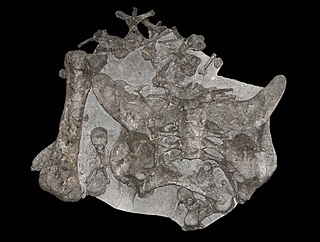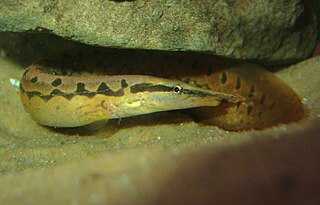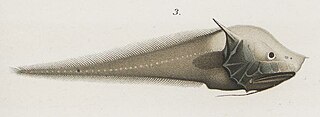
Hylaeosaurus is a herbivorous ankylosaurian dinosaur that lived about 136 million years ago, in the late Valanginian stage of the early Cretaceous period of England. It was found in the Grinstead Clay Formation.

Dacentrurus, originally known as Omosaurus, is a genus of stegosaurian dinosaur from the Late Jurassic to Early Cretaceous of Europe. Its type species, Omosaurus armatus, was named in 1875, based on a skeleton found in a clay pit in the Kimmeridge Clay in Swindon, England. In 1902 the genus was renamed Dacentrurus because the name Omosaurus had already been used for a crocodylian. After 1875, half a dozen other species would be named but perhaps only Dacentrurus armatus is valid. Finds of this animal have been limited and much of its appearance is uncertain. It was a heavily built quadrupedal herbivore, adorned with plates and spikes, reaching 8–9 metres (26–30 ft) in length and 5 metric tons in body mass.

The abyssal grenadier, Coryphaenoides armatus, is an abyssal fish of the genus Coryphaenoides, found in all the world's oceans, at depths between 800 and 4,000 metres. Its adult length is 20 to 40 centimetres, although Fishbase gives lengths up to 1 metre. The abyssal grenadier's body is unique in that it contains two dorsal spines and about 124 dorsal soft rays, which are the flexible jointed rays supporting a fin nearest to the back in the spinal column. It has no anal spines, but has 115 anal soft rays along its body. The head and eyes of this fish are very large, while the mouth is very small. The color of the abyssal grenadier is brown apart from the abdomen, which is bluish.

Portunus trituberculatus, the gazami crab, South Korea's blue crab or horse crab, is the most widely fished species of crab in the world. It is found off the coasts of East Asia and is closely related to Portunus armatus.
Flavius Armatus, also known as Harmatius, was an Eastern Roman military commander, magister militum under Emperors Leo I, Basiliscus and Zeno, and consul. He was instrumental in the rebellion of Basiliscus against Zeno, and in his subsequent fall.

The Uinta ground squirrel, commonly called a "chisler" and Potgut in northern Utah, is a species of rodent native to the western United States.

The zig-zag eel, also known as the tire-track eel, tire-track spiny eel or marbled spiny eel, is a species of ray-finned, spiny eels belonging to the genus Mastacembelus of the family Mastacembelidae, and is native to the riverine fauna of India, Bangladesh, Pakistan, Sri Lanka, Thailand, Vietnam, Indonesia and other parts of Southeast Asia. The species was described as Macrognathus armatus by Lacepède in 1800. Other common names for this popular aquarium species are leopard spiny eel and white-spotted spiny eel. This species is not only a popular aquarium fish but also as a food fish in its country of origin.

Aelia Zenonis was Eastern Roman empress as the wife of Basiliscus. Her ancestry is unknown.

Lestodon is an extinct genus of megafaunal ground sloth from South America during the Pliocene to Pleistocene periods. Its fossil remains have been found in Argentina, Paraguay, Uruguay, Venezuela, Bolivia, and Brazil. Measuring approximately 4.6 metres (15 ft) from snout to tail tip, it is estimated to have weighed 3,600–4,100 kilograms. It was a herbivore and primarily fed on the grasses on the South American plains and is thought to perhaps have used its semi-bipedal stance to obtain foliage from trees. Lestodon is placed as member of the Mylodontidae as indicated by the lobed form of the last tooth in the dentition.

Pagurus armatus, the armed hermit crab or black-eyed hermit crab, is a species of hermit crab found in the eastern Pacific Ocean of the United States and British Columbia, Canada.
Onoulphus, also Onoulf, Unulf and Hunulf was a general of the late fifth century of Scirian origin. He served as magister militum per Illyricum from 477 to 479 as a general of the Eastern Roman Empire, then afterwards was a general for his brother Odoacer, king of Italy, until their death.

The bony-eared assfish is a bathypelagic species of cusk-eel found in tropical and sub-tropical oceans at depths of from 1,171 to 4,415 metres. It has been found as far north as Queen Charlotte Sound off British Columbia's coast. This species grows to a length of 37.5 centimetres (14.8 in) SL. It is the only known member of its genus Acanthonus.
Phrynidius is a genus of beetles in the family Cerambycidae, containing the following species:
Phrynidius asper is a species of beetle in the family Cerambycidae. It was described by Henry Walter Bates in 1885.
Phrynidius echinoides is a species of beetle in the family Cerambycidae. It was described by Breuning in 1940.
Phrynidius echinus is a species of beetle in the family Cerambycidae. It was described by Bates in 1880. It is known from Honduras, Guatemala, and Panama.
Phrynidius inaequalis is a species of beetle in the family Cerambycidae. It was described by Say in 1835. It is known from Mexico and Honduras.
Phrynidius salvadorensis is a species of beetle in the family Cerambycidae. It was described by Franz in 1954. It contains two subspecies, P. salvadorensis montecristensis and P. salvadorensis salvadorensis.
Phrynidius singularis is a species of beetle in the family Cerambycidae. It was described by Bates in 1880. It is known from Mexico, Guatemala, and Honduras.
Portunus armatus is a species of crustacean, a swimming crab in the family Portunidae found in Australia and eastwards to New Caledonia. Common names include blue swimmer crabs, Blue manna, Blueys, and Jennies. The species was originally considered as a geographic variation of Portunus pelagicus, however in 2010 the Portunus pelagicus species was reviewed using DNA, as well as physical characteristics including measurements and four species recognised: Portunus pelagicus, Portunus armatus, Portunus reticulatis and Portunus segnis. The range of Portunus armatus overlaps with Portunus pelagicus in the Northern Territory of Australia.









